|
Men
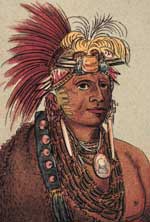
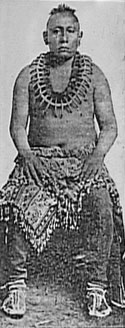
|
Kaw men saw themselves primarily as hunters, trappers, and warriors. The
pursuit and capture of small game and larger animals such as bison, deer, and
elk was an essential activity that benefited the tribe both in terms of food
gathering and as a means of commerce with Europeans and Americans.
The Kaws had many Indian enemies with
whom they continuously engaged in raids and counter-raids. Boys
and young men were encouraged and trained to be warriors to
protect their tribe from enemy attacks and to win honors by
demonstrating bravery in battle. Raiding other tribes,
particularly the hated Pawnees, was considered a legitimate way
of acquiring wealth and giving the booty away was a means of
gaining stature within the tribe.
Ne-Ca-Que-ba-na (The One Who Runs Down
Men) at different times ran down and killed eighteen Pawnees
with a knife. Each time he returned to the Kaw villages with a
drove of horses he captured. Once he distributed one hundred
fifty horses to three Kaw chiefs.
Most of the men plucked their arms, chins,
eyebrows, and most of the scalp with a wire apparatus. A narrow
strip of hair was left on top and in the back and was sometimes
colored with vermilion or decorated with the tail feather of a
war eagle. An important chief might attach a deer tail on the
back of his neck.
|
|
Most males wore a blue or red breech-cloth which was held on
with a girdle, plus leggings and moccasins made from deer skins. A blanket was
used in cold weather. They decorated their ears with beads, tin trinkets, or
porcelain sticks, and many had tattoos. Some of them had collars made from bear
claws or metal buttons that they fastened around their neck or leggings. The
warriors carried lances, swords, and bows and arrows.
|
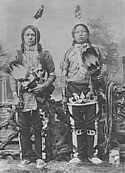 |
Women
"Stepping inside, we were greeted with a shouting sound, like
"how? How?" The lords and masters we found smoking and
card-playing, old and young. The squaws (ladies) were making or
ornamenting leggins or moccasins. Some, old and young, sat around their
centre-fires, tailor fashion, talking away lustily–very likely about
their white intruders, and their pale, sickly appearance. Some of them
had quite a number of buffalo robes, prepared and unprepared, which they
were selling."
---Dr. C. H. Gran, Leavenworth Kansas Weekly Herald, July 21,
1855
|
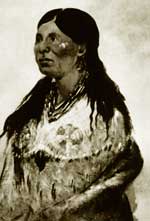

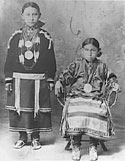
|
Kaw women performed almost all of the domestic tasks. Women
planted, tended, and harvested the crops such as corn, beans, pumpkins,
potatoes, and squash and foraged for nuts, berries, and roots. They processed,
stored, and cooked the food. They often accompanied the men on the bison hunts,
butchering the animals where they had fallen. The women dried the meat and
dressed the bison robes and other animal skins.
Prior to European contact, women made clothing from animal
skins. They decorated the clothing with porcupine quills, and later beadwork.
Women were responsible for stitching the bison hides into tepee covers, putting
up and taking down the tepees, and gathering the firewood.
They also looked after the children and trained the girls
in the domestic skills.
Although their lives were filled with tasks of drudgery, Kaw
women found ways to entertain themselves, usually while in the process of
working. They would gossip, gamble, play games with their children, and make up
songs. They also danced and trilled their approval of Kaw men who had
performed deeds of valor.
Kaw women wore a coarse cloth secured to their waists
with a belt. A loosely attached shoulder garment was sometimes worn, as were
moccasins and leggings. They wore their hair in long braids often tinted with
vermilion.
|
|
Children
Kaw girls were expected to accept their roles as domestic servants and
emulated their mothers and grandmothers in domestic skills. They worked hard. A
ten-to-twelve-year-old could carry a one hundred pound load of firewood on her
back for up to nine miles.
Boys were trained to be brave warriors. To facilitate the
development of a headstrong disposition, Kaw adults seldom disciplined the
boys.
When twelve or thirteen years of
age, Kaw boys, like many youth of the central Plains
tribes, under the tutelage of an elder, would go on
a vision quest. The young boy would go off by himself
for at least four days, without food or water. During
this time he would invoke the spirits by introspection,
wailing, and sometimes self-inflicted torture. Visions
would appear to him that determined his identity and
spirit helpers. Animals and supernatural phenomena appeared,
having special meanings. The images of these beings
were later painted on war shields and tipi covers to
constantly remind the youth of his vision-derived powers
and responsibilities.
|
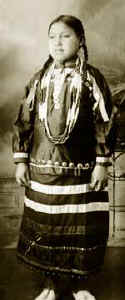 |
Marriage
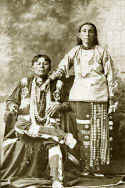
|
Most Kaw families traced descent through the male line. No male could marry a
kinswoman, no matter how remote the relationship. Chastity among unmarried
females was guarded by the mother with great care. Polygamy was sometimes
practiced among the Kaws, usually with a married woman’s younger sisters
becoming her husband’s wives when they reached the proper age.
If caught in adultery, the woman might be whipped or even
killed by her spouse. A male adulterer might be killed by the irate husband
without fear of penalty. Divorce was reached by a mutual agreement, and
both husband and wife were free to marry again
|
Many of the prominent Kaw chiefs or warriors had
daughters who married French fur traders. The French believed that to
accept the daughters of a chief was a prerequisite to negotiations for Kaw
furs.
Thomas Huffaker, the Kaw Mission teacher, wrote
the following account of a Kaw marriage:
"The relatives of the man go the relatives of the girl and agree upon
the consideration. The groom moves his tent near the family of the girl.
On the day of the ceremony, the tent of the groom is vacated by
the family. The presents of the groom’s relatives are left in the
tent, except the ponies, which are tied outside, and four women
relatives of the groom remain in the tent. The bride is clothed in all
the fine and costly things that her family are able to furnish. She is
then placed upon the finest horse possessed by her family, it
having been decorated with costly coverings. A gun is then discharged at
her tent to notify the four women at the groom’s tent that the
bride has started for the groom’s tent. The four women leave the tent
to meet her. She is taken by them from the horse, wrapped in fine clothing
and carried by the four women into the tent and seated upon the ground
uncovered. The friends of the groom are then notified, and he is brought
into the tent and seated near the bride, when they both partake
of a wedding feast, seated back to back, "sight unseen." After
the repast is ended the relatives and friends of
both parties are admitted to the tent, a general feast is had, and the
delivery of the presents. Thus the ceremony is ended."
Homes
 |
When the Kaws resided in the heavily
timbered valleys of the Lower Ohio and Missouri rivers, their
lodges were patterned after the Eastern woodland style. They
were constructed mainly of a pole frame covered with a thick,
mat-like fabric of leaves, bark, and branches.
|
| As
the Kaws migrated westward onto the grass-covered plains, they
tended to substitute earth or wood for at least the lower walls
of their conical huts. Bison and deer skins covered the pole
frame of the tepees, the form of shelter the Kaws employed
during their twice-yearly hunting excursions to the High Plains.
Tepees also appear to have been used in the permanent villages
on the Council Grove Reservation.
White Americans periodically visited the Kaw
village site near present Manhattan, known as the Blue
Earth Village. Occupied by the entire Kaw tribe from 1795
until 1830, this village contained one hundred twenty-eight
"earth lodges." These round, closely-spaced lodges had
diameters ranging from thirty to sixty feet.
Timber piles arranged in a circle were
driven into the ground with four to five feet of the timbers
left above ground. Pole rafters were attached to these piles at
an angle of six or seven degrees. Interior wooden pillars
supported the roof. These rafters were joined together at the
apex of the conical roof, leaving a small aperture to allow
smoke to escape from interior fireplaces. The frame was covered
by a layer of poles, mats, and bark which in turn was covered by
slabs of sod.
|
|
Some of the Blue
Earth Village lodges were rectangular, generally sixty feet long
and twenty-five feet wide. They were constructed of stout
saplings and poles arranged in the form of a common garden arbor
and covered with skins, bark and mats. Along the interior walls
were wood platforms, raised about two feet from the ground, on
which were placed the skins, food, weapons, and other personal
property belonging to the three to five families living under
one roof. Adjacent to the platforms were the family fireplaces,
which were simple holes in the earth situated to allow smoke an
easy passage out of the common opening in the roof.
|
 |
|
Food |
|

|
Kaw people provided food for themselves by hunting,
raising crops, and foraging for edible wild plants. Of all the food sources,
however, bison meat was the mainstay of the Kaw diet. Twice a year, in the
spring and fall, the entire Kaw tribe would travel west to present central and
western Kansas to hunt bison.
|
|
Nearly every part
of the bison flesh was used for food.. Preservation techniques
involved Kaw women cutting bison meat into long strips,
plaiting, and drying it, either on crude scaffolds or simply by
wrapping it around short poles driven into the ground. Later the
meat was cured with salt, most of which was obtained from the
Saline River north of the Arkansas River. Even the fat was used,
being preserved in casings fashioned out of the buffalo’s
intestines.
|
 |
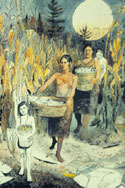
|
Corn, beans, pumpkins, prairie potatoes, muskmelons, and
watermelons were cultivated by Kaw women wielding simple hoes. George Sibley,
who visited the Blue Earth Village in 1811, reported that about one hundred
acres of corn, beans, and pumpkins had been planted near the village.
Corn was either roasted on the cob or cooked in a soup
with beans and buffalo meat. Sometimes it was dried and wrapped in skins and
stored underground for later use. It was cured in early fall before the
semiannual trip to buffalo country. The Kaws shared their corn, even if in
meager supply, with friendly tribes or travelers.
|
|
Fish, fowl, venison, berries, nuts, and tubers were also
important elements in the Kaw diet.
|
|
Games
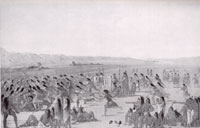
|
Athletic competitions, horse racing, and gambling were popular diversions for Kaw
men. Competitive displays of physical prowess included leaping, racing,
and wrestling. Warriors raced their favorite horses, often for a wager against
their opponent. Gambling was commonplace, especially for men with substantial
wealth in horses, robes, guns, and other articles available as stakes.
|
|
Meetings
for these games, which included a rudimentary form of dice, were usually held in
the lodge of a chief. For the Kaw warrior to ignore an invitation was to lose
favor and suffer possible permanent exclusion from the chief’s lodge.
The few leisure moments Kaw girls enjoyed were spent
playing with dolls and playhouses they fashioned themselves or simulating other
domestic activities. Boys had more time to practice archery, running, lance
throwing, and a sort of mimic hunting that soon involved the actual chase of
small birds and animals. Both Kaw boys and girls engaged in indoor guessing
games.
|
Music and Dance
Music was an important ceremonial aspect of Kaw culture and
held great importance in the performance of the various tribal
dances. A dominant feature was rhythm, which was maintained by
thumping animal-hide drums and shaking deer’s foot rattles
tied to strings. Sometimes Kaws played wooden flutes. Often a
lively chant accompanied the instrument sounds, providing a
great personal enjoyment to the Kaw participants.
The Kaws performed at least seventeen
different dances, including some reserved exclusively for women
and others for men. Family, thanksgiving, medicine,
track-finding, hide, calumet, war and death dances were
exceedingly popular.
|
|
The Scalp Dance
One of the most detailed accounts of a Kaw dance was made by
Reverend Joab Spencer, who described a performance of a scalp
dance in 1867 after the Kaws had successfully killed a
Cheyenne chief and several warriors in a surprise attack near
Dodge City. Although he had lived with the Kaws for over a
year, Spencer’s narrative reflects the usual cultural biases
and limitations of whites who observed Native American behavior
and customs: |
 |
|
"When I reached the village the dance was in progress. The
scalps recently secured were hung on a pole erected in the midst of the village.
Only men [sic] dance among the Indians. The dancers arranged themselves in a
straight line, or in a circle, one just behind the other, assuming a stooping
position with the knees bent forward enough to balance the body. The dance
consisted of a kind of shuffling moving and a spring up of a few inches from the
ground. This gave them a bobbing-up-and-down notion, but did not move them from
their position. An onlooker would see a line of men shuffling and jumping but
not changing place. Their dances were very serious affairs and continued far
into the night. The dancers had a grave and serious look, and seemed to give
close attention to their work. If a dancer tired he would step out of line. If
another wished to join, he stepped into line at any time. How men could endure
such exercise for hours without recess, is hard to understand. This dance, as
well as all others, was a religious ceremony, and was really a thanksgiving
service for their late victory, which they regarded
as proof that the Great Spirit was not angry, but pleased with them.
They danced to music, or rather with music. The performer
accompanied the drum with an improvised song, in which he recited the brave
feats of the warriors in the battle in which the scalps had been taken. I took a
position by the interpreter and he explained the words of the song as it
progressed. Of course they were without rhyme or measure. We remained for some
time before going home, but long into the night we could hear the monotonous
drum-beat and occasionally a yell from some dusty son of the prairie.
"The Cheyenne braves came into our wigwams;
high-e-ye-ye; high-e-ye-ye
They smoked with us the pipe of peace;
high-e-ye-ye; high-e-ye-ye
They said they were friends, but they were enemies;
high-e-ye-ye; high-e-ye-ye"
In this way the song would proceed until all of the
incidents of the battle were described, or until singers and dancers were tired
out."
|
Burial
Disease and death became frequent and devastating events for the
Kaws,
especially after they had been located to the Neosho Valley
Reservation near Council Grove. When they arrived in 1848, the Kaws
number sixteen hundred. When they were exiled from Kansas
in 1873, only six hundred Kaws made the trip to Indian
Territory. In response to the frequency of death among their
people, the Kaws developed elaborate funerary practices.
|
|
Preparation of the corpse for burial was
largely the responsibility of the women, especially members of
the deceased’s family. After the face had been painted and the
body covered with bark and a buffalo robe, an old man might talk
to the corpse, giving directions to the world of the dead. The
body was then placed in a shallow individual grave, usually
located on a hill or bluff near the village. The body lie in a
horizontal position with the head facing the life-giving east.
Other reports tell of the corpse being
placed in a sitting posture, facing west, with arms crossed and
knees flexed. In either case, the deceased person’s garments,
weapons, utensils, pipe, and a supply of corn, beans, and dried
buffalo meat were deposited in the burial pit, for use by the
deceased during the journey ahead.
|


|
|
Finally, after
earth and rock slabs had been placed over the grave, the dead
man’s horse might be killed (usually by strangulation) and
left on top of the grave. Soon after burial the Kaws believed
that the spirit of the deceased would travel to live in a spirit
village. These spirit villages were believed to be located at or
near the site of the Kaw village occupied immediately
preceding the present one.
|
 |
|


